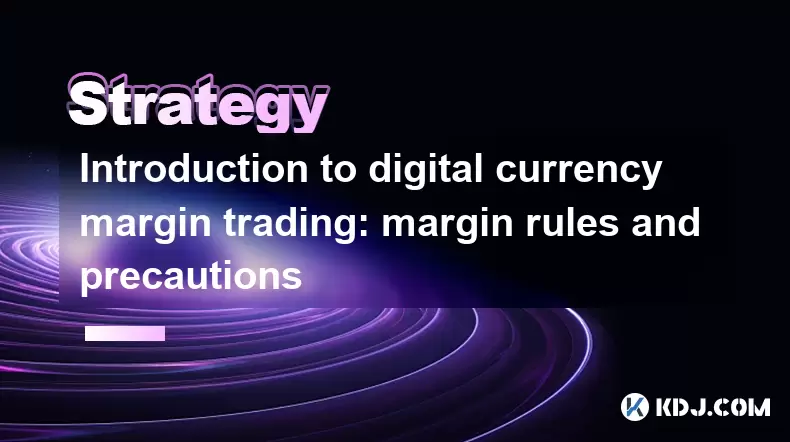-
 bitcoin
bitcoin $114320.977035 USD
-0.40% -
 ethereum
ethereum $4152.439985 USD
-1.75% -
 tether
tether $1.000111 USD
-0.04% -
 xrp
xrp $2.843037 USD
-1.63% -
 bnb
bnb $1013.349380 USD
-1.62% -
 solana
solana $208.362767 USD
-2.10% -
 usd-coin
usd-coin $0.999783 USD
0.00% -
 dogecoin
dogecoin $0.232559 USD
-1.00% -
 tron
tron $0.333491 USD
-1.09% -
 cardano
cardano $0.806310 USD
0.19% -
 hyperliquid
hyperliquid $45.023720 USD
-1.59% -
 ethena-usde
ethena-usde $1.000819 USD
-0.06% -
 chainlink
chainlink $21.241249 USD
-2.11% -
 avalanche
avalanche $30.035416 USD
-0.66% -
 stellar
stellar $0.364984 USD
-2.05%
Introduction to digital currency margin trading: margin rules and precautions
Digital currency margin trading amplifies returns but increases risks; understanding exchange rules and using precautions like low leverage and stop-loss orders is crucial.
Jun 06, 2025 at 01:35 am

Digital currency margin trading has become a popular way for traders to amplify their potential returns. By borrowing funds to trade, investors can take larger positions than their actual capital would allow. However, this comes with increased risks and complexities. Understanding the margin rules and taking necessary precautions is crucial for anyone looking to engage in this high-stakes trading environment.
Understanding Margin Trading Basics
Margin trading in the context of digital currencies involves borrowing funds to trade cryptocurrencies. The borrowed funds are used as leverage to increase the potential returns on an investment. Leverage is typically expressed as a ratio, such as 2:1, 5:1, or even 100:1, meaning that for every dollar of the trader's own money, they can borrow an additional amount up to the specified ratio.
In margin trading, the trader must maintain a minimum amount of equity in their account, known as the margin requirement. If the account's equity falls below this threshold, the trader may face a margin call, requiring them to deposit more funds or close positions to restore the required margin level.
Margin Rules and Requirements
Different exchanges have varying rules and requirements for margin trading. It is essential to thoroughly understand the specific margin rules of the exchange you are using. Common margin rules include the initial margin requirement, which is the amount of equity needed to open a position, and the maintenance margin, which is the minimum equity required to keep the position open.
For example, if an exchange has an initial margin requirement of 50%, a trader would need to deposit $500 to open a $1,000 position. If the maintenance margin is set at 25%, the account must maintain at least $250 in equity to keep the position open. Failing to meet the maintenance margin can trigger a margin call.
The Process of Opening a Margin Position
To open a margin position, follow these steps:
- Register and verify your account on a cryptocurrency exchange that offers margin trading.
- Deposit funds into your account to meet the initial margin requirement.
- Navigate to the margin trading section of the exchange.
- Select the cryptocurrency pair you wish to trade.
- Choose your leverage ratio and the amount you want to trade.
- Submit your order to open the margin position.
Managing Margin Calls
A margin call occurs when the value of the trader's account falls below the maintenance margin level. Prompt action is required to address a margin call. The trader has two main options:
- Deposit additional funds into the account to meet the margin requirement.
- Close or reduce positions to decrease the required margin.
Failure to address a margin call can result in the exchange automatically liquidating positions to cover the borrowed funds. Understanding and preparing for margin calls is a critical aspect of margin trading.
Risks and Precautions in Margin Trading
Margin trading amplifies both gains and losses, making it a high-risk activity. Several precautions can help mitigate these risks:
- Start with low leverage: Beginners should start with lower leverage ratios to minimize potential losses.
- Set stop-loss orders: These can help limit losses by automatically closing positions when they reach a certain price.
- Monitor positions closely: Regularly check your account to stay aware of your margin levels and market movements.
- Diversify your portfolio: Avoid putting all your capital into a single trade to reduce the impact of a potential loss.
- Educate yourself: Continuously learn about market trends, trading strategies, and the specific rules of your chosen exchange.
Common Mistakes to Avoid
Many traders fall into common pitfalls when engaging in margin trading. Some of the most frequent mistakes include:
- Over-leveraging: Using too much leverage can lead to rapid and significant losses.
- Ignoring margin calls: Failing to respond to margin calls can result in forced liquidation.
- Emotional trading: Making decisions based on emotions rather than strategy can lead to poor outcomes.
- Lack of research: Entering trades without understanding the market and the assets involved can be disastrous.
Frequently Asked Questions
Q: Can I lose more money than I invest in margin trading?A: Yes, with margin trading, it is possible to lose more than your initial investment. If the market moves against your position, you may be required to deposit additional funds to meet margin calls, and if you fail to do so, your positions can be liquidated at a loss.
Q: How do I calculate the margin requirement for a trade?A: The margin requirement is calculated based on the initial margin percentage set by the exchange. For example, if the initial margin requirement is 50% and you want to open a $1,000 position, you would need to deposit $500 as margin.
Q: What happens if I can't meet a margin call?A: If you cannot meet a margin call, the exchange may automatically liquidate your positions to cover the borrowed funds. This can result in significant losses, as the liquidation may occur at unfavorable prices.
Q: Is margin trading suitable for beginners?A: Margin trading is generally not recommended for beginners due to its high risk and complexity. It is advisable for new traders to gain experience with regular trading before venturing into margin trading.
Disclaimer:info@kdj.com
The information provided is not trading advice. kdj.com does not assume any responsibility for any investments made based on the information provided in this article. Cryptocurrencies are highly volatile and it is highly recommended that you invest with caution after thorough research!
If you believe that the content used on this website infringes your copyright, please contact us immediately (info@kdj.com) and we will delete it promptly.
- BlockDAG, DOGE, HYPE Sponsorship: Crypto Trends Shaping 2025
- 2025-10-01 00:25:13
- Deutsche Börse and Circle: A StableCoin Adoption Powerhouse in Europe
- 2025-10-01 00:25:13
- BlockDAG's Presale Buzz: Is It the Crypto to Watch in October 2025?
- 2025-10-01 00:30:13
- Bitcoin, Crypto, and IQ: When Genius Meets Digital Gold?
- 2025-10-01 00:30:13
- Stablecoins, American Innovation, and Wallet Tokens: The Next Frontier
- 2025-10-01 00:35:12
- NBU, Coins, and Crypto in Ukraine: A New Yorker's Take
- 2025-10-01 00:45:14
Related knowledge

Practical parameter settings for a Bitcoin multi-timeframe moving average system
Sep 18,2025 at 10:54pm
Optimizing Timeframe Combinations for Bitcoin Trading1. Selecting appropriate timeframes is crucial when building a multi-timeframe moving average sys...

How can I filter out false breakouts in Dogecoin high-frequency trading?
Sep 22,2025 at 01:00am
Understanding False Breakouts in Dogecoin Trading1. A false breakout occurs when Dogecoin's price appears to move beyond a defined support or resistan...

Techniques for identifying tops and bottoms in the Bitcoin on-chain NVT model
Sep 20,2025 at 07:54pm
Understanding the NVT Model in Bitcoin Analysis1. The Network Value to Transactions (NVT) ratio is often described as the 'P/E ratio' of the cryptocur...

What does the surge in open interest in Bitcoincoin futures mean?
Sep 20,2025 at 11:18pm
Understanding the Surge in Dogecoin Futures Open Interest1. A surge in open interest within Dogecoin futures indicates a growing number of active cont...

How can I use the Ethereum USDT premium to gauge market sentiment?
Sep 18,2025 at 11:55pm
Understanding the Ethereum USDT Premium1. The Ethereum USDT premium refers to the price difference between USDT (Tether) traded on Ethereum-based plat...

What should I do if Ethereum staking yields decline?
Sep 20,2025 at 06:18am
Understanding the Causes Behind Declining Ethereum Staking Yields1. The Ethereum network transitioned to a proof-of-stake consensus mechanism with the...

Practical parameter settings for a Bitcoin multi-timeframe moving average system
Sep 18,2025 at 10:54pm
Optimizing Timeframe Combinations for Bitcoin Trading1. Selecting appropriate timeframes is crucial when building a multi-timeframe moving average sys...

How can I filter out false breakouts in Dogecoin high-frequency trading?
Sep 22,2025 at 01:00am
Understanding False Breakouts in Dogecoin Trading1. A false breakout occurs when Dogecoin's price appears to move beyond a defined support or resistan...

Techniques for identifying tops and bottoms in the Bitcoin on-chain NVT model
Sep 20,2025 at 07:54pm
Understanding the NVT Model in Bitcoin Analysis1. The Network Value to Transactions (NVT) ratio is often described as the 'P/E ratio' of the cryptocur...

What does the surge in open interest in Bitcoincoin futures mean?
Sep 20,2025 at 11:18pm
Understanding the Surge in Dogecoin Futures Open Interest1. A surge in open interest within Dogecoin futures indicates a growing number of active cont...

How can I use the Ethereum USDT premium to gauge market sentiment?
Sep 18,2025 at 11:55pm
Understanding the Ethereum USDT Premium1. The Ethereum USDT premium refers to the price difference between USDT (Tether) traded on Ethereum-based plat...

What should I do if Ethereum staking yields decline?
Sep 20,2025 at 06:18am
Understanding the Causes Behind Declining Ethereum Staking Yields1. The Ethereum network transitioned to a proof-of-stake consensus mechanism with the...
See all articles










































































